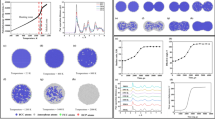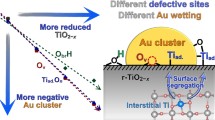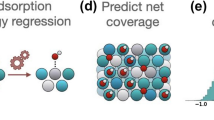Abstract
Ozone has attracted more scholars’ attention due to its less environmental injury during oxidation. Oxidation with ozone has been more regarded because ozone evaluates oxygen and can form a terrific oxide layer even at lower temperatures compared to oxygen. This work investigated the Al(100) surface oxidation simulations by O2 and O3 molecules at 400, 600, and 800 K temperatures with the reactive force field (ReaxFF) method. In separate simulation boxes, one hundred ozone molecules and 150 oxygen molecules have been placed in a space above the Al(100) surfaces to examine this metal’s behavior with them (gases incipient density of 0.47 g/cm3). We found further growth of the oxide layer in the case of ozone-aluminum. Subsequently, we surveyed the correlation between temperatures and the development of alumina layers in the case of oxygen and ozone in separate sets through ReaxFF simulation to untangle the mechanism of oxidation kinetics of the Al(100) surface by ozone. Even though there are demonstrated constraints on growing an oxide layer with ozone and oxygen, it is possible to produce a thicker oxide layer at lower temperatures using ozone. Here, we used LAMMPS as our program package for all simulations and used reactive molecular dynamics simulation, which is a relatively inexpensive tool for studying complex conditions that are impossible to reproduce with other techniques.
Graphical Abstract










Similar content being viewed by others
Data Availability
The authors declare that the data supporting the findings of this study are available within the paper and any data related to the finding are available from the corresponding author upon request.
References
Chan GH, Zhao J, Schatz GC, Van Duyne RP (2008) Localized surface plasmon resonance spectroscopy of triangular aluminum nanoparticles. J Phys Chem C, Nanomater Interfaces 112(36):13958–13963. https://doi.org/10.1021/jp804088z
Taylor R, Coulombe S, Otanicar T, Phelan P, Gunawan A, Lv W, Rosengarten G, Prasher R, Tyagi H (2013) Small particles, big impacts: a review of the diverse applications of nanofluids. J Appl Phys 113(1):011301. https://doi.org/10.1063/1.4754271
Dokhan A, Price E, Seitzman J, Sigman R (2002) The effects of bimodal aluminum with ultrafine aluminum on the burning rates of solid propellants. Proc Combust Inst 29(2):2939–2946. https://doi.org/10.1016/s1540-7489(02)80359-5
Gańczyk-Specjalska K, Zygmunt A, Cieślak K, Gołofit T, Gańczyk-Specjalska K, Kasztankiewicz A (2017) Application and properties of aluminum in primary and secondary explosives. J Elementol 2/2017. https://doi.org/10.5601/jelem.2016.21.3.1073
DeLuca LT (2018) Overview of Al-based nanoenergetic ingredients for solid rocket propulsion. Def Technol 14(5):357–365. https://doi.org/10.1016/j.dt.2018.06.005
Wang F, Wu Z, Shangguan X, Sun Y, Feng J, Li Z, Chen L, Zuo S, Zhuo R, Yan P (2017) Preparation of mono-dispersed, highenergy release, core/shell structure Al nanopowders and their application in HTPB propellant as combustion enhancers. Sci Rep 7(1):5228. https://doi.org/10.1038/s41598-017-05599-0
Shih TS, Liu ZB (2006) Thermally-formed oxide on aluminum and magnesium. Mater Trans 47(5):1347–1353. https://doi.org/10.2320/matertrans.47.1347
Jeurgens LPH, Sloof WG, Tichelaar FD, Mittemeijer EJ (2002) Growth kinetics and mechanisms of aluminum-oxide films formed by thermal oxidation of aluminum. J Appl Phys 92(3):1649–1656. https://doi.org/10.1063/1.1491591
Yang W, Luo ZP, Bao WK, Xie H, You ZS, Jin HJ (2021) Light, strong, and stable nanoporous aluminum with native oxide shell. Sci Adv 7(28):9471. https://doi.org/10.1126/sciadv.abb9471
van Gogh ATM, van der Molen SJ, Kerssemakers JWJ, Koeman NJ, Griessen R (2000) Performance enhancement of metal-hydride switchable mirrors using Pd/AlOx composite cap layers. Appl Phys Lett 77(6):815–817. https://doi.org/10.1063/1.1306643
Gloos K, Koppinen PJ, Pekola JP (2003) Properties of native ultrathin aluminium oxide tunnel barriers. J Phys: Condens Matter 15(10):1733–1746. https://doi.org/10.1088/0953-8984/15/10/320
Petford-Long AK, Ma YQ, Cerezo A, Larson DJ, Singleton EW, Karr BW (2005) The formation mechanism of aluminum oxide tunnel barriers: three-dimensional atom probe analysis. J Appl Phys 98(12):124904. https://doi.org/10.1063/1.2149188
Gutiérrez G, Johansson B (2002) Molecular dynamics study of structural properties of amorphous Al2O3. Phys Rev B 65(10):104202. https://doi.org/10.1103/physrevb.65.104202
Dreizin EL (1996) Experimental study of stages in aluminium particle combustion in air. Combust Flame 105(4):541–556. https://doi.org/10.1016/0010-2180(95)00224-3
Alavi S, Mintmire JW, Thompson DL (2004) Molecular dynamics simulations of the oxidation of aluminum nanoparticles. J Phys Chem B 109(1):209–214. https://doi.org/10.1021/jp046196x
Aykol M, Persson KA (2018) Oxidation protection with amorphous surface oxides: thermodynamic insights from ab initio simulations on aluminum. ACS Appl Mater Amp Interfaces 10(3):3039–3045. https://doi.org/10.1021/acsami.7b14868
Rai A, Park K, Zhou L, Zachariah MR (2006) Understanding the mechanism of aluminium nanoparticle oxidation. Combust Theor Model 10(5):843–859. https://doi.org/10.1080/13647830600800686
Henz BJ, Hawa T, Zachariah MR (2010b) Atomistic simulation of the aluminum nanoparticle oxidation mechanism. 48th AIAA Aerospace Sciences Meeting Including the New Horizons Forum and Aerospace Exposition, AIAA 2010–336. https://doi.org/10.2514/6.2010-336
Chu Q, Shi B, Liao L, Luo KH, Wang N, Huang C (2018) Ignition and oxidation of core–shell Al/Al2O3 nanoparticles in an oxygen atmosphere: insights from molecular dynamics simulation. J Phys Chem C, Nanomater Interfaces 122(51):29620–29627. https://doi.org/10.1021/acs.jpcc.8b09858
Hasnaoui A, Politano O, Salazar JM, Aral G, Kalia RK, Nakano A, Vashishta P (2005) Molecular dynamics simulations of the nano-scale room-temperature oxidation of aluminum single crystals. Surf Sci 579(1):47–57. https://doi.org/10.1016/j.susc.2005.01.043
Hasani S, Panjepour M, Shamanian M (2012) The oxidation mechanism of pure aluminum powder particles. Oxid Met 78(3–4):179–195. https://doi.org/10.1007/s11085-012-9299-1
Jeurgens L, Sloof W, Tichelaar F, Mittemeijer E (2002) Structure and morphology of aluminium-oxide films formed by thermal oxidation of aluminium. Thin Solid Films 418(2):89–101. https://doi.org/10.1016/s0040-6090(02)00787-3
Amiri N, Ghasemi JB, Behnejad H (2021) Atomistic insights into the protection failure of the graphene coating under the hyperthermal impacts of reactive oxygen species: ReaxFF-based molecular dynamics simulations. Appl Surface Sci 554:149606. https://doi.org/10.1016/j.apsusc.2021.149606
Kazor A, Gwilliam R, Boyd IW (1994) Growth rate enhancement using ozone during rapid thermal oxidation of silicon. Appl Phys Lett. https://doi.org/10.1063/1.112318
Gupta S, Hannah S, Watson CP, Šutta P, Pedersen RH, Gadegaard N, Gleskova H (2015) Ozone oxidation methods for aluminum oxide formation: application to low-voltage organic transistors. Org Electron 21:132–137. https://doi.org/10.1016/j.orgel.2015.03.007
Ridgway HF, Mohan B, Cui X, Chua KJ, Islam MR (2017) Molecular dynamics simulation of gas-phase ozone reactions with sabinene and benzene. J Mol Graph Model 74:241–250. https://doi.org/10.1016/j.jmgm.2017.04.020
Lian Z, Zhu C, Zhang S, Ma W, Zhong Q (2021) Study on the synergistic oxidation of sulfite solution by ozone and oxygen: kinetics and mechanism. Chem Eng Sci 242(116745):116745. https://doi.org/10.1016/j.ces.2021.116745
Kim MJ, Nriagu J (2000) Oxidation of arsenite in groundwater using ozone and oxygen. Sci Total Environ 247(1):71–79. https://doi.org/10.1016/s0048-9697(99)00470-2
Kuznetsova A, Yates JT, Zhou G, Yang JC, Chen X (2001) Making a superior oxide corrosion passivation layer on aluminum using ozone. Langmuir: ACS J Surf Colloids 17(7):2146–2152. https://doi.org/10.1021/la001300x
Fink C, Nakamura K, Ichimura S, Jenkins SP (2009) Silicon oxidation by ozone. J Phys: Condens Matter 21(18):183001. https://doi.org/10.1088/0953-8984/21/18/183001
Ramanathan S, Chi D, McIntyre PC, Wetteland C, Tesmer JR (2003) Ultraviolet-ozone oxidation of metal films. J Electrochem Soc 150(5):F110. https://doi.org/10.1149/1.1566416
Karwowska B, Sperczyńska E (2022) Organic matter and heavy metal ions removal from surface water in processes of oxidation with ozone, UV irradiation, coagulation and adsorption. Water 14(22):3763. https://doi.org/10.3390/w14223763
Wang L, Tao Y, Su B, Liu P (2022) Environmental and health risks posed by heavy metal contamination of groundwater in the Sunan coal mine. China Toxics 10(7):390. https://doi.org/10.3390/toxics10070390
Evertsson J, Bertram F, Zhang F, Rullik L, Merte LR, Shipilin M, Soldemo M, Ahmadi S, Vinogradov N, Carlà F, Weissenrieder J, Göthelid M, Pan J, Mikkelsen A, Nilsson J-O, Lundgren E (2015) The thickness of native oxides on aluminum alloys and single crystals. Appl Surf Sci 349:826–832. https://doi.org/10.1016/j.apsusc.2015.05.043
Zhang C, Abdijalilov K, Grebel H (2007) Surface enhanced Raman with anodized aluminum oxide films. J Chem Phys 127(4):044701. https://doi.org/10.1063/1.2752498
Gheribi AE, Poncsák S, Guérard S, Bilodeau J-F, Kiss L, Chartrand P (2017) Thermal conductivity of the sideledge in aluminium electrolysis cells: experiments and numerical modelling. J Chem Phys 146(11):114701. https://doi.org/10.1063/1.4978235
Flötotto D, Wang ZM, Jeurgens LPH, Mittemeijer EJ (2014) Intrinsic stress evolution during amorphous oxide film growth on Al surfaces. Appl Phys Lett 104(9):091901. https://doi.org/10.1063/1.4867471
Liyanage LSI, Kim S-G, Houze J, Kim S, Tschopp MA, Baskes MI, Horstemeyer MF (2014) Structural, elastic, and thermal properties of cementite (Fe3C) calculated using a modified embedded atom method. Phys Rev B, Condens Matter Mater Phys 89(9):094102. https://doi.org/10.1103/physrevb.89.094102
Wei J, Zhou W, Li S, Shen P, Ren S, Hu A, Zhou W (2019) Modified embedded atom method potential for modeling the thermodynamic properties of high thermal conductivity beryllium oxide. ACS Omega 4(4):6339–6346. https://doi.org/10.1021/acsomega.9b00174
van Duin ACT, Dasgupta S, Lorant F, Goddard WA (2001) ReaxFF: a reactive force field for hydrocarbons. Jl Phys Chem A 105(41):9396–9409. https://doi.org/10.1021/jp004368u
Senftle TP, Hong S, Islam MM, Kylasa SB, Zheng Y, Shin YK, Junkermeier C, Engel-Herbert R, Janik MJ, Aktulga HM, Verstraelen T, Grama A, van Duin ACT (2016) The ReaxFF reactive force-field: development, applications and future directions. NPJ Comput Mater 20(1):15011. https://doi.org/10.1038/npjcompumats.2015.11
Nomura K-I, Kalia RK, Nakano A, Rajak P, Vashishta P (2020) RXMD: a scalable reactive molecular dynamics simulator for optimized time-to-solution. SoftwareX 11(100389):100389. https://doi.org/10.1016/j.softx.2019.100389
Hong S, van Duin ACT (2015) Molecular dynamics simulations of the oxidation of aluminum nanoparticles using the ReaxFF reactive force field. J Phys Chem C, Nanomater Interfaces 119(31):17876–17886. https://doi.org/10.1021/acs.jpcc.5b04650
Rahnamoun A, Kaymak MC, Manathunga M, Götz AW, van Duin ACT, Merz KM, Aktulga HM (2020) ReaxFF/AMBER—a framework for hybrid reactive/nonreactive force field molecular dynamics simulations. J Chem Theory Comput 16(12):7645–7654. https://doi.org/10.1021/acs.jctc.0c00874
Mortier WJ, Ghosh SK, Shankar S (1986) Electronegativity-equalization method for the calculation of atomic charges in molecules. J Am Chem Soc 108(15):4315–4320. https://doi.org/10.1021/ja00275a013
Ilyin DV, Goddard WA 3rd, Oppenheim JJ, Cheng T (2019) First-principles-based reaction kinetics from reactive molecular dynamics simulations: application to hydrogen peroxide decomposition. Proc Natl Acad Sci USA 116(37):18202–18208. https://doi.org/10.1073/pnas.1701383115
Amiri N, Behnejad H (2016) Oxidation of nickel surfaces through the energetic impacts of oxygen molecules: reactive molecular dynamics simulations. J Chem Phys 144(14):144705. https://doi.org/10.1063/1.4945421
Plimpton S (1995) Fast parallel algorithms for short-range molecular dynamics. J Comput Phys 117(1):1–19. https://doi.org/10.1006/jcph.1995.1039
Stukowski A (2010) Visualization and analysis of atomistic simulation data with OVITO–the Open Visualization Tool. Model Simul Mater Sci Eng 18(1):015012. https://doi.org/10.1088/0965-0393/18/1/015012
Humphrey W, Dalke A, Schulten K (1996) VMD: visual molecular dynamics. J Mol Graph 14(1):33 38-27–28. https://doi.org/10.1016/0263-7855(96)00018-5
Trybula ME, Korzhavyi PA (2021) Temperature dependency of structure and order evolution in 2D confined oxide films grown on Al substrates using reactive molecular dynamics. Vacuum 190(110243):110243. https://doi.org/10.1016/j.vacuum.2021.110243
Trybula ME, Korzhavyi PA (2019) Atomistic simulations of Al(100) and Al(111) surface oxidation: chemical and topological aspects of the oxide structure. J Phys Chem C 123(1):334–346. https://doi.org/10.1021/acs.jpcc.8b06910
Jensen KMØ (2021) Characterization of nanomaterials with total scattering and pair distribution function analysis: examples from metal oxide nanochemistry. Chimia 75(5):368–375. https://doi.org/10.2533/chimia.2021.368
Gutiérrez G, Belonoshko AB, Ahuja R, Johansson B (2000) Structural properties of liquidAl2O3: a molecular dynamics study. Phys Rev 61(3):2723–2729. https://doi.org/10.1103/physreve.61.2723
Li G, Niu L, Hao W, Liu Y, Zhang C (2020) Atomistic insight into the microexplosion-accelerated oxidation process of molten aluminum nanoparticles. Combust Flame 214:238–250. https://doi.org/10.1016/j.combustflame.2019.12.027
Sankaranarayanan SKRS, Kaxiras E, Ramanathan S (2009) Atomistic simulation of field enhanced oxidation of Al (100) beyond the Mott potential. Phys Rev Lett 102(9):095504. https://doi.org/10.1103/PhysRevLett.102.095504
Hasnaoui A, Politano O, Salazar JM, Aral G (2006) Nanoscale oxide growth on Al single crystals at low temperatures: variable charge molecular dynamics simulations. Phys Rev B, Condens Matter Mater Phys 73(3):035427. https://doi.org/10.1103/physrevb.73.035427
Perron A, Garruchet S, Politano O, Aral G, Vignal V (2010) Oxidation of nanocrystalline aluminum by variable charge molecular dynamics. J Phys Chem Solids 71(2):119–124. https://doi.org/10.1016/j.jpcs.2009.09.008
Chen L, Luo H, Li Z, Sha A (2021) Effect of Al doping on the early-stage oxidation of Ni-Al alloys: a ReaxFF molecular dynamics study. Appl Surf Sci 563(150097):150097. https://doi.org/10.1016/j.apsusc.2021.150097
Kazor A, Boyd IW (1993) Ozone-induced rapid low temperature oxidation of silicon. Appl Phys Lett 63(18):2517–2519. https://doi.org/10.1063/1.110467
Li Y, Kalia RK, Nakano A, Vashishta P (2013) Size effect on the oxidation of aluminum nanoparticle: multimillion-atom reactive molecular dynamics simulations. J Appl Phys 114(13):134312. https://doi.org/10.1063/1.4823984
Koike K, Fukuda T, Ichimura S, Kurokawa A (2000) High-concentration ozone generator for oxidation of silicon operating at atmospheric pressure. Rev Sci Instrum 71(11):4182. https://doi.org/10.1063/1.1310340
Larson TV, Horike NR, Harrison H (1978) Oxidation of sulfur dioxide by oxygen and ozone in aqueous solution: a kinetic study with significance to atmospheric rate processes. Atmos Environ 12(8):1597–1611. https://doi.org/10.1016/0004-6981(78)90308-6
Cyster MJ, Smith JS, Vogt N, Opletal G, Russo SP, Cole JH (2021) Simulating the fabrication of aluminium oxide tunnel junctions. Npj Quantum Inf 7(1):12. https://doi.org/10.1038/s41534-020-00360-4
Acknowledgements
We would like to express our sincere thanks to the Research Council of the University of Tehran for the financial support of this work.
Author information
Authors and Affiliations
Corresponding author
Ethics declarations
Conflict of interest
The authors declare that they have no conflicts of interest or personal relationships that could have appeared to influence the work reported in this paper. Hassan Behnejad reports administrative support and equipment, or supplies provided by the University of Tehran. The University of Tehran accounts a relationship that includes board membership.
Additional information
Publisher's note
Springer Nature remains neutral with regard to jurisdictional claims in published maps and institutional affiliations.
Rights and permissions
Springer Nature or its licensor (e.g. a society or other partner) holds exclusive rights to this article under a publishing agreement with the author(s) or other rightsholder(s); author self-archiving of the accepted manuscript version of this article is solely governed by the terms of such publishing agreement and applicable law.
About this article
Cite this article
Saidinik, F., Behnejad, H. Comparing oxidation of aluminum by oxygen and ozone using reactive force field molecular dynamics simulations. J Nanopart Res 25, 95 (2023). https://doi.org/10.1007/s11051-023-05739-w
Received:
Accepted:
Published:
DOI: https://doi.org/10.1007/s11051-023-05739-w




